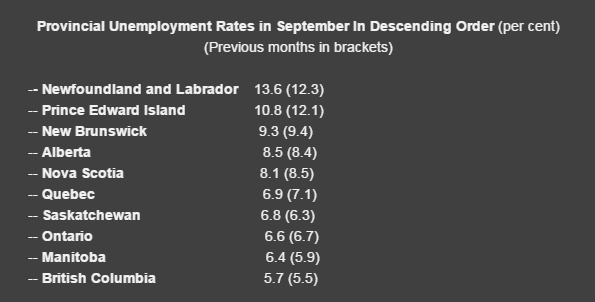Articles
Posted on October 7, 2016
September Jobs Reports, Canada and US
A perfect example of the unpredictable volatility in the Canadian jobs report, the September gain of 67,000 jobs was dramatically larger than economists’ expectations of roughly 7,500 new jobs. Most of the rise was in part-time work, however, and it was boosted by 50,000 additional self-employed workers, which tempers the excitement over the outsized strength in payrolls last month. In other words, take this news with a grain of salt.
The September figures round out the third quarter data, posting the strongest quarterly growth of the year. Q3 employment increased by 62,000 (up 0.3%), following little gain in the wild-fire battered second quarter and a 33,000 gain in Q1.
More people entered the labour force, which is good news, keeping the unemployment rate unchanged at 7.0%.
Year-over-year, payrolls rose by 139,000 (0.8%), but most of the growth was in part-time work and the total number of hours worked rose only 0.2%, indicative of an underperforming economy.
Gains were posted in Quebec, Alberta and New Brunswick, with little change in the other provinces. Quebec’s job scene improved for the second consecutive month taking the unemployment rate down a tick to 6.9%, its lowest level since early 2008. While employment in Alberta increased 13,000 last month, year-over-year gains were still down, as 47,000 (-2.0%) fewer people held jobs in the province and the jobless rate was up 1.9 percentage points to 8.5%. Alberta’s economy remains mired in recession. (See table below for the unemployment rate in the other provinces.)
Bottom Line: Although the employment gains were much stronger than expected, the details of the report continue to show a less vibrant picture with much of the improvement in the labour market in self-employment and part-time jobs. Bank of Canada Senior Deputy Governor Wilkins stated in a speech yesterday that the unemployment rate belies actual excess capacity in the labour market, which has been most evident recently in slowing wage growth. The Bank has been disappointed by the pace at which excess capacity has been absorbed, and revisions to their growth forecasts in the October Monetary Policy Report shows slack persisting for longer than previously projected.This is consistent with the Bank of Canada’s forecast for continued slow growth and will do nothing to move the Bank off of the sidelines in the near term, despite an imminent Fed rate hike. A slowing housing market in response to Monday’s Department of Finance announcement of measures to reduce mortgage lending and home sales might well lead the Bank to cut interest rates once again next year.

US Jobs Report Shows More Americans Re-Enter the Labour Market
Although the headline payrolls gain of 156,000 missed estimates and the jobless rate edged up a tick to a six-month high of 5.0%, the overall message is is positive. Wage rates continue to edge upward as labour markets tighten and the average work week for all workers is rising. Indeed, there are reports in the Fed’s regional survey, the Beige Book, of labour shortages in trucking, construction, and technology. While there is still slack in the economy, some sectors are seeing jobs go unfilled.
The underemployment rate, which includes part-time workers who would prefer to work full-time and people who want work but have given up looking, remained unchanged at 9.7% in September.
Record job openings drew more Americans into the workforce. The labour force participation rate, which shows the share of working-age people in the labour force, increased to 62.9% from 62.8%. It has been hovering near its lowest level in more than 30 years. Improving prospects for jobs will underpin further wage gains, boosting consumer spending, which has been the driving component of the U.S.growth this year. Today’s report, along with improving durable goods orders, consumer sentiment, and exports, will encourage the Federal Reserve to follow through on its forecast to raise interest rates by the end of the year–likely at its December meeting.